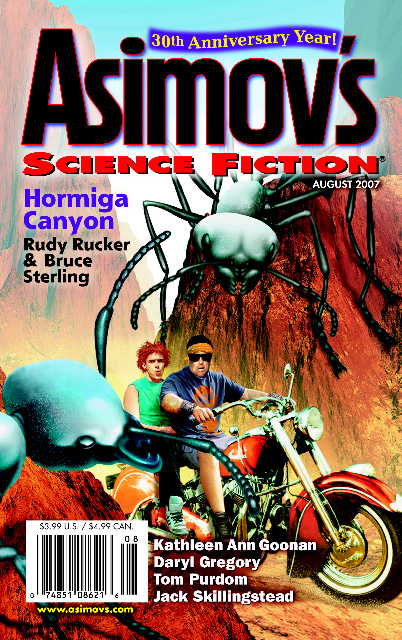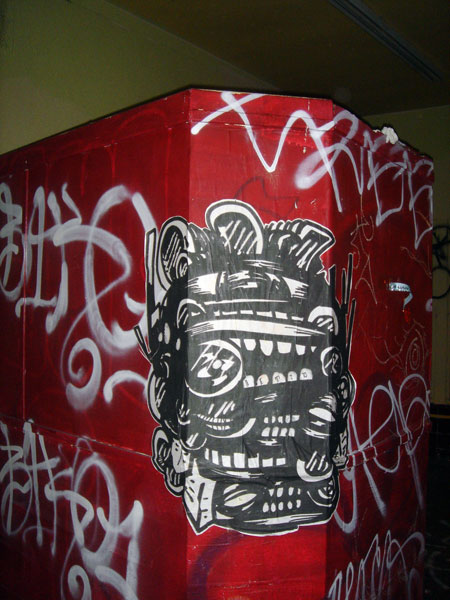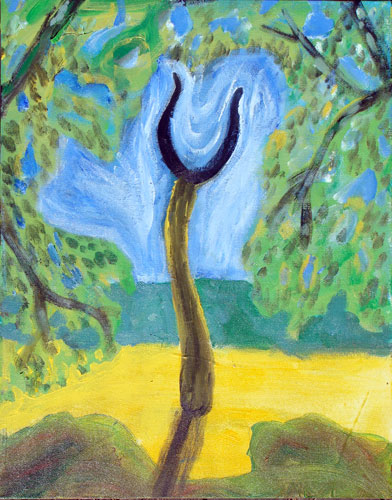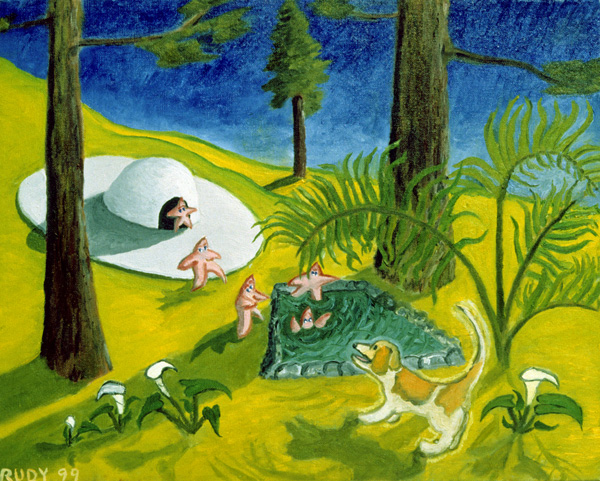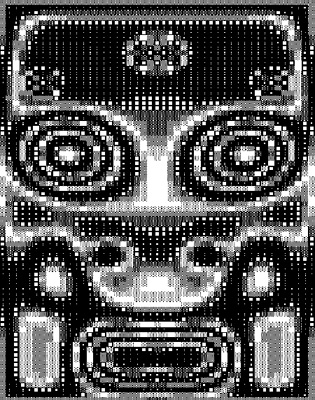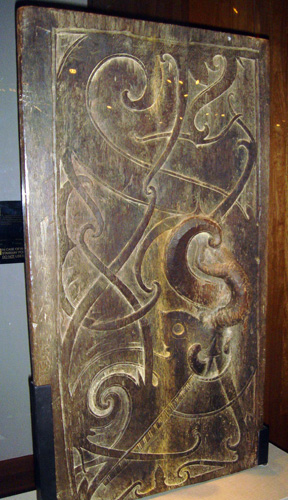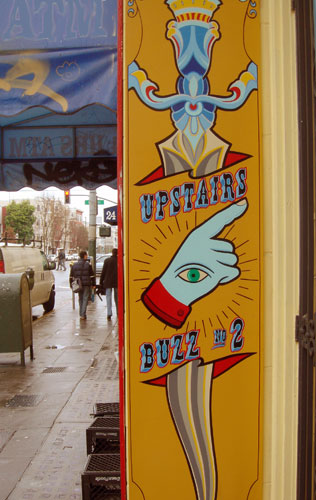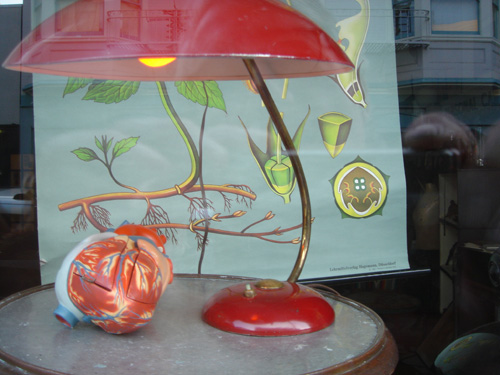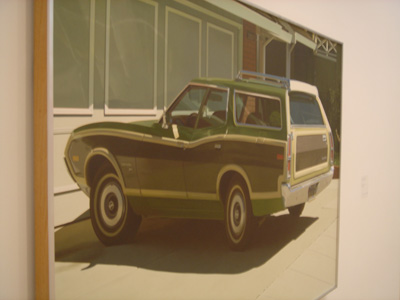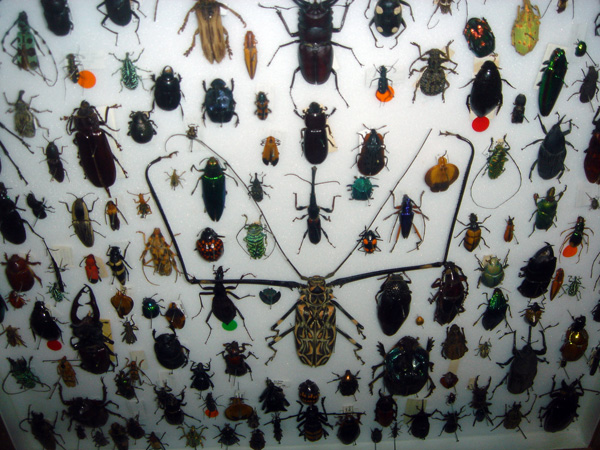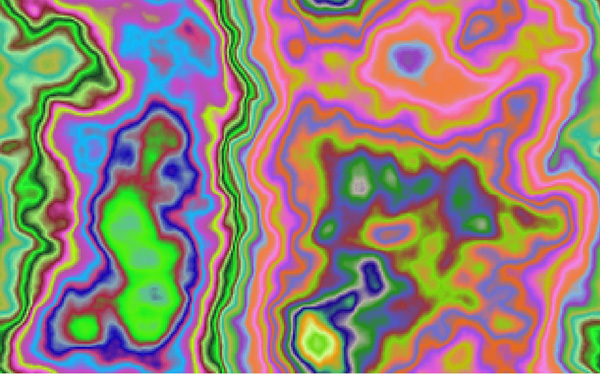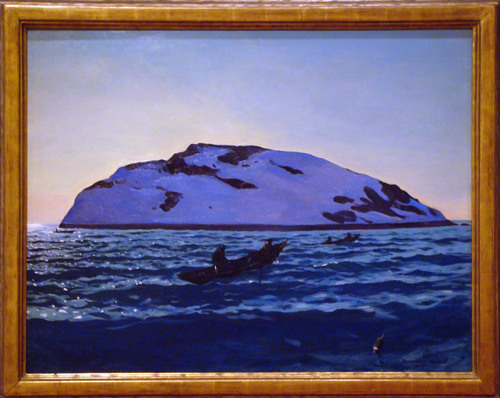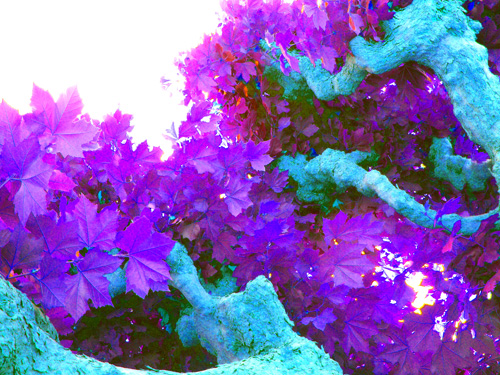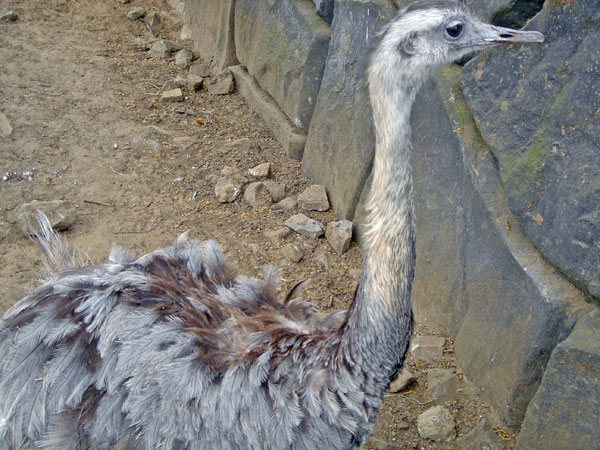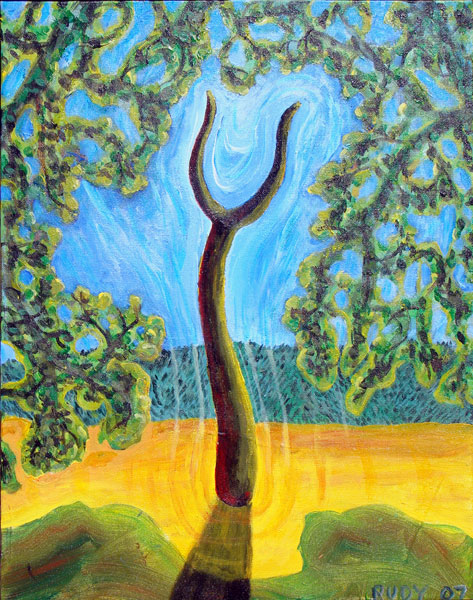
I did what may be the final version of my painting, “The Evil Pitchork,” on August 1. I was inspired by some email advice I got from a good artist, Aletha Kuschan. Aletha made the point that you should try and record all the things you see—not by phororealistically copying them, but rather by working for a period of time thinking about each thing. So today I went back to the picture to take account of (if not correctly represent) the fact that the centers of leaf bunches are quite dark in silhouette. Also I added vibration lines around the Evil Pitchfork, as so many of you readers keep comparing it to a tuning fork.

[This was my second draft of my painting, “The Evil Pitchork,” on July 30. There’s always the worry that earlier drafts were better… No Undo key in acrylic painting!]
The harp is more or less good. We need a rival higher being. A male. A pitchfork, like I discussed in the entry before this. The evil pitchfork vs. the magic harp.

The old peasant pitchforks were made all of wood. With no metal. They found a branch that happened to have the two prongs, and then the peeled the bark and hardened the prongs in fire. So we have a smooth twisty piece of gray wood with blackened tines.
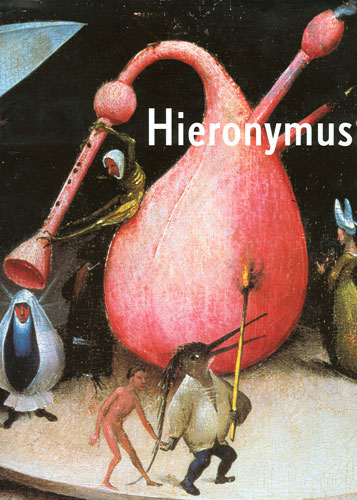
Bosch likes to dress up as a peddler so he can hang out with beggars, sketching them. On the outings, he carries Jayjay in a sack like a pet imp.
They go on an outing to a peasant fair. At the party Jayjay sees something that scares him. He has an upset stomach from eating some gnarly pickled herring; he goes off to crap in the woods; and looking out from under a tree at a sunny meadow, he sees a two-tined pitchfork standing on its butt in a field, hopping. The evil pitchfork. It gives off a note, like a tuning-fork.
After seeing the evil pitchfork sunning himself in the meadow, Jayjay starts (correctly?) seeing the pitchfork in every forked branch. He sees the perhaps-not-so-trustworthy-after-all harp in every triangle. Panicking, he finds comfort in the music of a squalling bagpipe made of an inside-out sheep.

So now I’m trying to fit the pitchfork into my tale. At the (boring) logical level I know that this is an arbitrary story pattern that I stumbled upon haphazardly.
But at the (magical) creative level, I feel sure there has to be an underlying reason. A way to make sense of it.
I can’t let myself doubt this too soon. Otherwise I might give up too soon. If I petition the muse for a few days (i. e. obsess over this odd idea), I’ll find a higher picture that contains these shards.
This said, I also know that sometimes a particular set of assumptions and scenarios can’t be pieced together. Sometimes I need to back up and make more thorough-going revisions than I might have expected.
I’m pretty sure I can keep the harp and the pitchfork. But I’m not sure how it’s gonna work.
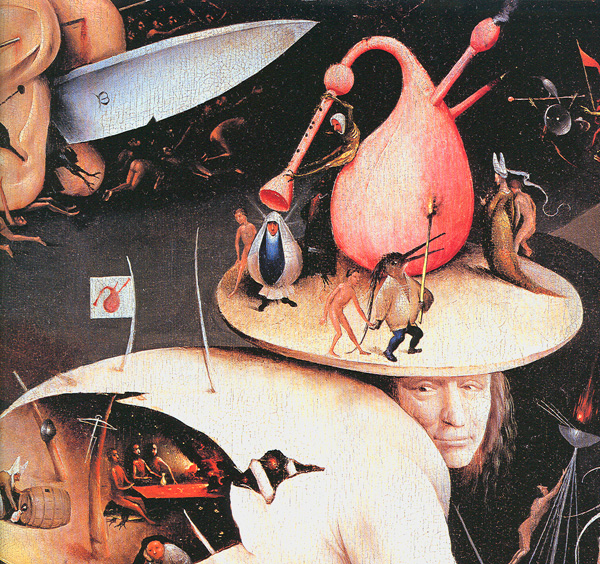
To begin with, let’s suppose that it was the pitchfork that Jayjay saw in his vision early in Hylozoic when he became a runemaster. Initially, in the vision, the pitchfork, was disguised as the harp, so Jayjay wouldn’t be scared of it.
But—the harp was undergoing a bizarre metamorphosis. One by one her strings were snapping and sinking into her frame. The post at her front end turned to taffy, melted in two, and the stubs sank into the frame leaving a shape like a U. And now, from the butt of the U, a bump grew out and lengthened.
Jayjay sprang back. The creature had turned into—a pitchfork? The pitchfork balanced on his single rubbery leg. No longer a she, but a he. The evil pitchfork’s two prongs were vibrating.
“Surprised?” said the pitchfork mockingly, his tines focusing an unbearable vibration upon Jayjay, a vibration that was at the same time a sound, a teep signal, a teek jostle—plus some oddball fourth ingredient. A higher-dimensional flip.

I want the magic harp and the evil pitchfork be transfinite beings which I’ll call aktuals, after Georg Cantor’s usage, “aktuale Unendliche,” meaning “actual infinity.”
As Cantor said, “The fear of infinity is a form of myopia that destroys the possibility of seeing the actual infinite, even though it in its highest form has created and sustains us, and in its secondary transfinite forms occurs all around us and even inhabits our minds.” This translation is drawn from my book Infinity and the Mind, p. 43, and the passage I based it on can be found in, “Ãœber die verschiedenen Standpunkte in bezug auf das aktuelle Unendliche,” Cantor’s collected works , pp. 374-375.
Our space is transfinite in the small and in the large. It’s a Hausdorff eta- Ω ordering, that is, an Ω-saturated ordering: between any two sets, you can find more points. Below any sequence of subdivisions lie more subdivisions. The levels go up forever as well.
In the potentially infinite real number line, the whole numbers march out to ω, and you can find an ω sequence running from 1 down to 0 just as well. By the same token in an absolutely continuous space you can march out to × -one on the ordinal line, but you can also find an × -one sequence running from 1 down to 0. And ditto for the Absolute Infinite Ω.
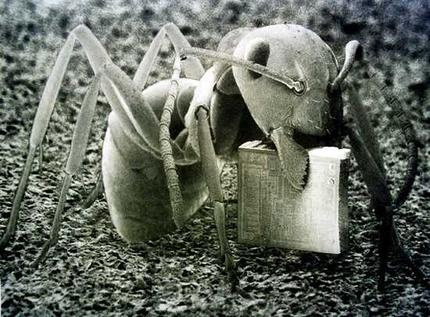
The aktuals don’t need to come from far away, that is, from beyond ω space or ω time. They can be down in the cracks and crevices, right here. The God within.

The harp has unfurled the eighth dimension on Earth, Hrullwelt, and Pengö, among other places. The harp wants these worlds to attain higher planetary minds, and she wants the locals to develop transfinite consciousness so they can be her allies. I might say that maybe it wasn’t her, maybe it was one of her cousins, but remember that, as an aktual, the harp is endlessly large, so she can be in many places at once.
[When Phil Dick called his book Ubik, was he thinking of “ubiquitous?”]
The pitchfork wants to kill off these uplifted worlds. The pitchfork doesn’t want to transfinite consciousness to spread. The pitchfork promotes war to bring suffering and wipe out more minds or at the very least to lower mortals’ consciousness.
Thus the harp and pitchfork play, in some measure, the roles of God and the Devil.

Also consider the harp and pitchfork as mathematical forms: the triangle and the fork. Cycle vs. bifurcation. Reversible vs. irreversible.
And as musical forms: harp is melody, pitchfork is a single tone.

Maybe our time is an illusion for the aktuals. Perhaps they stick a series of body manifestations into our spacetime that seem to link up into a worldline of a body, but which are really a series of still images, like a movie. An aktual seems to twinkle when you look at him or her, as they are disappearing and reappearing over and over.
But, no, taking them out of our time is a bad idea for this book. Why?
For the sake of drama and conflict, we expect characters be embedded in some kind of time flow. So if the aktuals aren’t in our time, then they must be in a higher-dimensional metatime. And if I have a metatime elapsing, then it’s likely that our sheet of spacetime is changing as metatime goes by—like in Mathematicians in Love—and I’d rather not tack on that complication to this book. I don’t want a lot of universes. I just want two: Lobrane and Hibrane. Given that these universes are probably of Absolute Infinite size, it’d be overkill to ask for more of them.
So I’ll submerge the aktuals in our time stream after all.
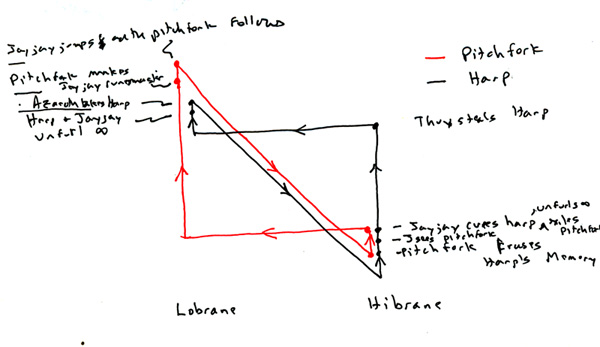
The harp and pitchfork both do happen to appear as closed temporal loops in the joint spacetime of Lobrane and Hibrane. Perhaps this is inevitable; perhaps this has to do with how they manifest themselves at the finite level.
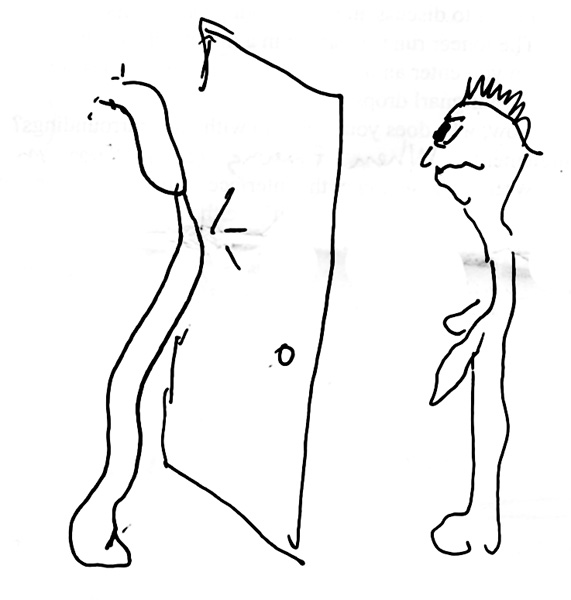
Studying the spacetime diagrams, I discover that the pitchfork has been in America making trouble since 1492. Vision of it knocking on someone’s door.
I just found this “screwed” version of “Pourin’ Up” made by a fan. It’s pretty vibby, although the fan put her picture over the corner for the whole run, which is cute in a way, also she used a version that has been edited to cut out the cursewords and drug refs. Might as well hear it all, right? Here’s a link to baseline unbowdlerized normal version of “Pourin Up” .The first guy to rap is Pimp C, then comes Mike Jones, andthen comes Bun B. It’s charming when Mike Jones is talking about his car and his friends “Pimp ‘n Bun.” As a mathematician, I like that they have single letter last names. Sometimes I call myself Pig E, with E for Elder.
I still find the lyrics to be too mean to women, but they’re certainly catchy. Maybe to some extent the harshness is just a convention, on the other hand, Pimp C did some jail time for aggravated assault. You can Wikipedia Bun B as well—Wikipedia’s waaay ahead of Britannica…
Relevance? Well, the fact that, for the aktuals the time stream is an Absolute Continuum might be of some significance. If they like, they can make a second of time drag out forever. Like Bun B and Pimp C.
I’m looking for help all over—Bosch, Cantor, Pimp ‘n Bun, whatever. Full court press. Somewhere the Cosmos has hidden the story for me to find.









